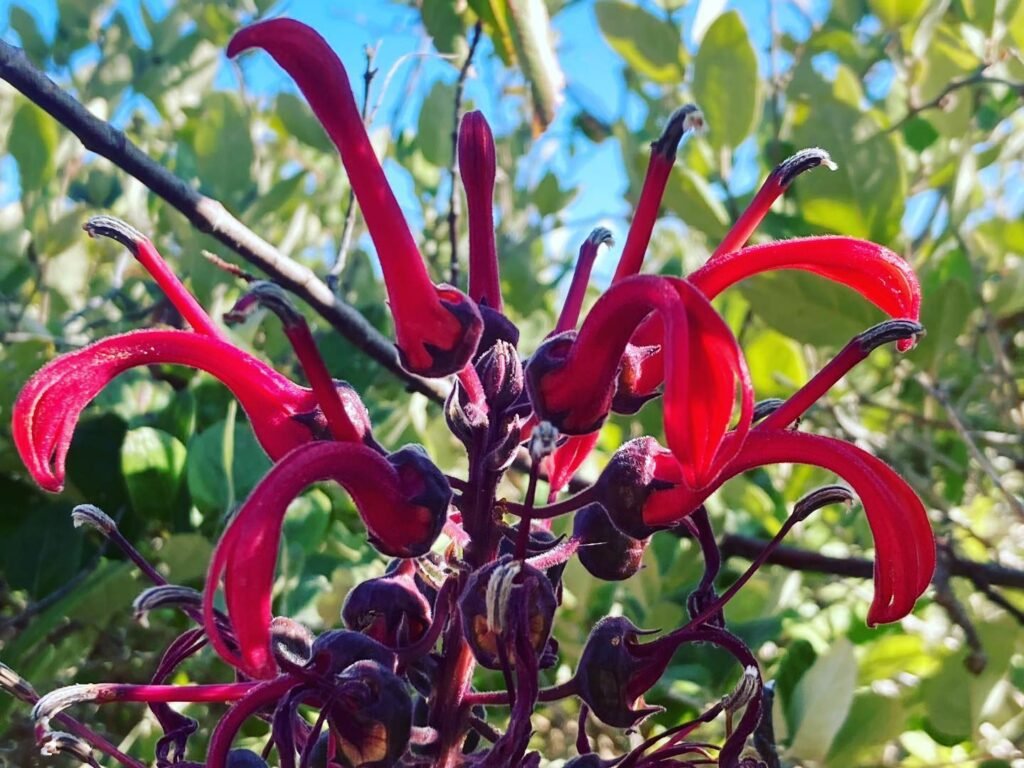Imagine stepping into your garden and being greeted by a burst of vibrant red flowers, standing tall and proud. They sway gracefully in the breeze, captivating your attention and filling the air with their alluring fragrance. This is the magic of Lobelia Tupa, also known as Devil’s Tobacco.
Appearance of Devil’s Tobacco (Lobelia Tupa)


Lobelia Tupa, also known as Devil’s Tobacco, is a captivating and striking perennial plant that can transform any UK garden into an exotic paradise. With its tall stature and vibrant red flowers, Lobelia Tupa adds a touch of drama and beauty to the landscape.
The flowers of Lobelia Tupa are trumpet-shaped and known for their intense red color. Blooming in late summer, they attract pollinators such as butterflies with their nectar-rich blooms. The elongated, lance-shaped leaves of Lobelia Tupa complement the striking appearance of the plant.
“With its vibrant red flowers and tall stance, Lobelia Tupa is a true showstopper in any garden.”
Lobelia Tupa can reach heights of up to 5 feet, making it an eye-catching addition to borders, containers, or as a focal point in the garden. Its majestic presence and vivid blooms create a stunning display that is difficult to ignore.
When it comes to growing conditions, Lobelia Tupa thrives in moist soil and prefers full sun to partial shade. To ensure its optimal growth and flourishing blooms, it’s important to provide the plant with adequate sunlight and a well-draining soil.
Key Points:
- Lobelia Tupa is characterized by its tall stature and vibrant red flowers.
- The trumpet-shaped flowers bloom in late summer and attract pollinators with their nectar.
- Lobelia Tupa prefers moist soil and full sun to partial shade.
- It can reach heights of up to 5 feet, making it a striking addition to any garden.
 Lobelia tupa, also known as Devil’s Tobacco, is fascinating not just for its looks. It’s been used by native people for its healing and mind-altering properties. Plus, it keeps pests away with its natural toxins, showing how it plays a clever part in nature’s balance.
Lobelia tupa, also known as Devil’s Tobacco, is fascinating not just for its looks. It’s been used by native people for its healing and mind-altering properties. Plus, it keeps pests away with its natural toxins, showing how it plays a clever part in nature’s balance.
Light Requirements for Lobelia Tupa
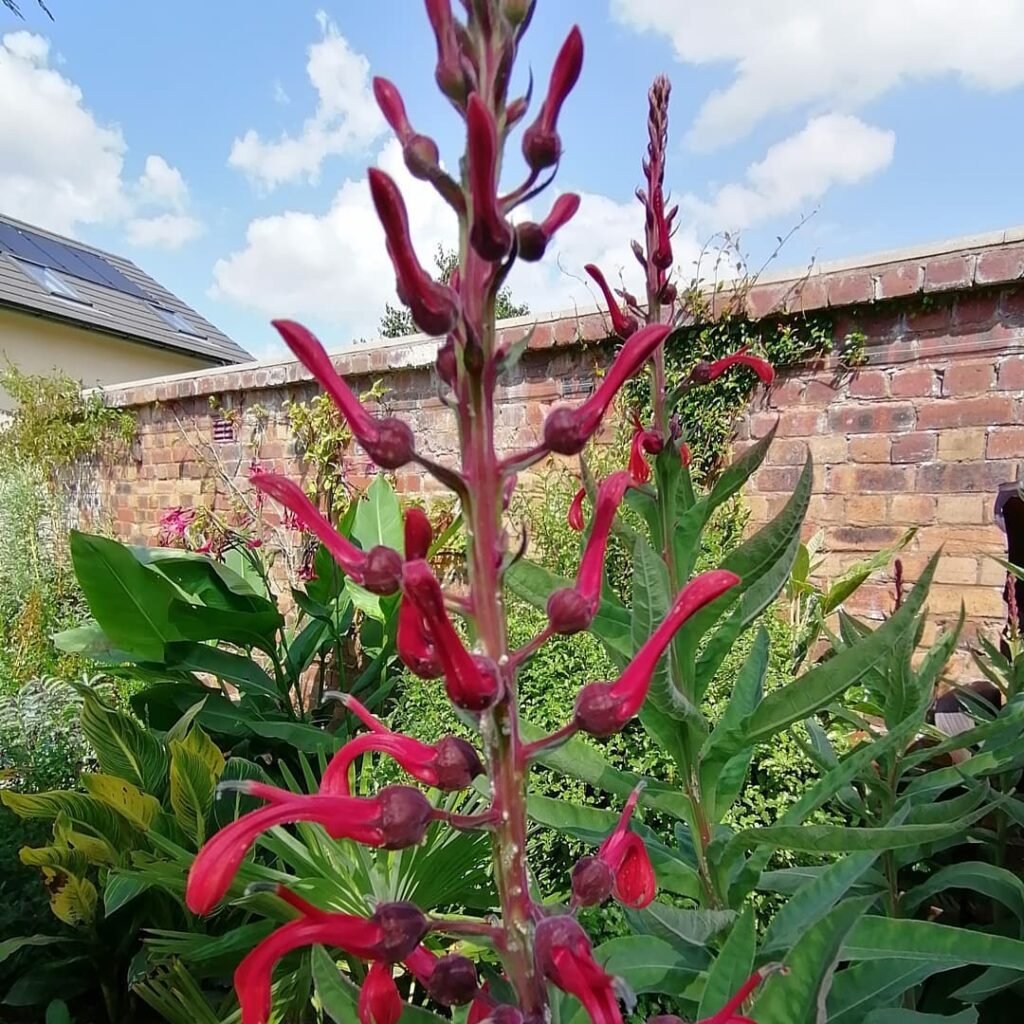

Lobelia Tupa, or Devil’s Tobacco, requires a specific amount of sunlight to thrive in UK gardens. To ensure optimal growth and blooming, it is essential to provide Lobelia Tupa with the right amount of light.
Ideally, Lobelia Tupa should be planted in an area that receives full sun to partial shade. It prefers bright and direct sunlight for at least 6 hours a day. However, in regions with intense sunlight, providing some shade during the hottest part of the day can be beneficial.
To determine the best location for planting Lobelia Tupa, choose an area that receives adequate sunlight throughout the day. This will enable the plant to photosynthesize efficiently and produce lush foliage and vibrant flowers.

Watering Tips for Lobelia Tupa (Devil’s Tobacco)

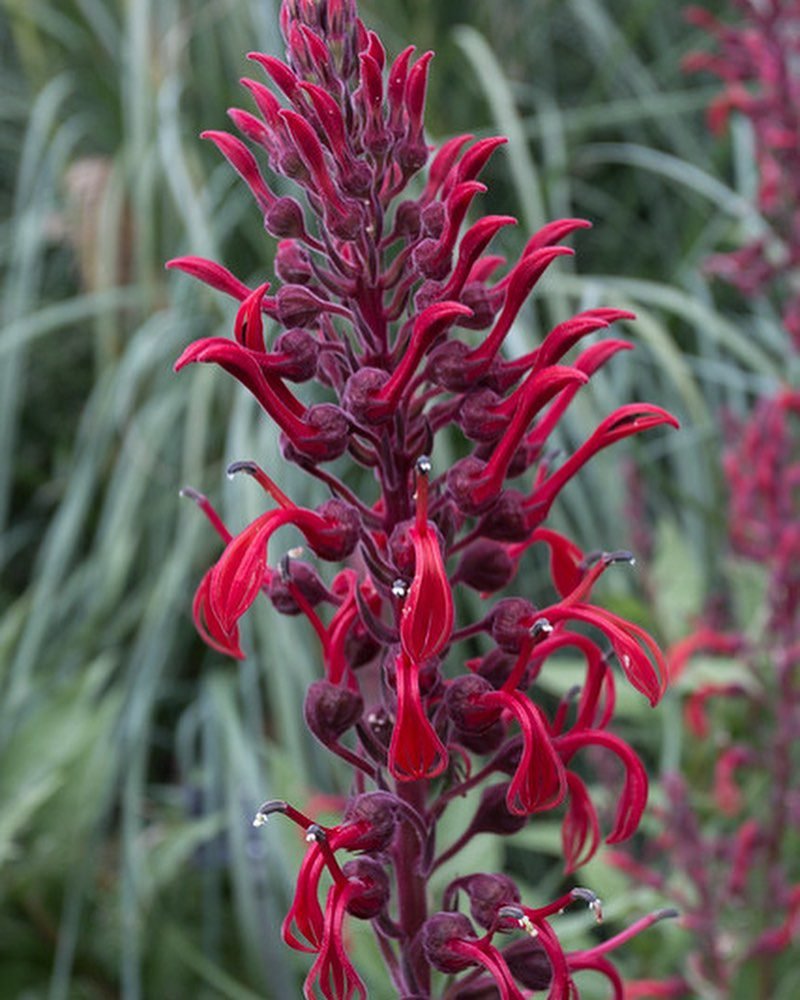
Proper watering is essential for the healthy growth and thriving of Lobelia Tupa in your garden. To ensure its success, follow these watering tips:
- Consistent Moisture: Lobelia Tupa prefers moist soil, so it is important to keep the soil consistently moist. However, be cautious not to overwater and make the soil waterlogged, as this can lead to root rot and other issues.
- Deep Watering: During dry spells or periods of prolonged heat, provide deep watering to ensure the roots receive sufficient moisture. This helps prevent the plant from drying out and promotes healthy growth.
- Avoid Overhead Watering: Overhead watering, such as using a sprinkler, can lead to foliar diseases and fungal issues. Instead, opt for watering at the base of the plant to keep the foliage dry and minimize the risk of disease.

Fertilizing and Soil for Lobelia Tupa

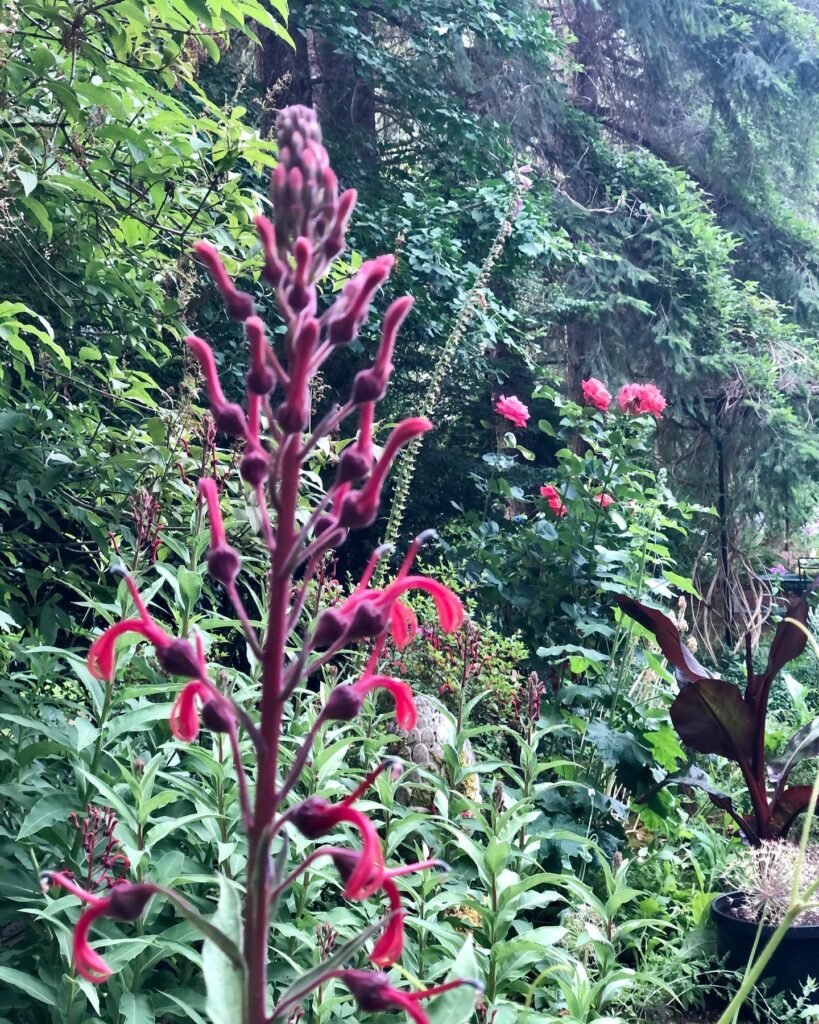
When it comes to caring for Lobelia Tupa, the right soil and fertilization are essential for its healthy growth and vibrant blooms. Here are some tips to ensure your Lobelia Tupa thrives:
Preparing the Soil
Before planting Lobelia Tupa, it’s important to amend the soil to create the ideal growing conditions. This plant prefers rich and well-draining soil. To improve soil fertility and drainage, incorporate organic matter, such as compost, into the soil. This will provide the necessary nutrients and help the soil retain moisture without becoming waterlogged.
Fertilizing Lobelia Tupa
To keep your Lobelia Tupa healthy and blooming, regular fertilization is key. Using a slow-release fertilizer with a balanced formulation is recommended. Apply the fertilizer once a month during the growing season, following the package instructions for the correct application rates. This will ensure that your Lobelia Tupa receives a steady supply of essential nutrients for optimal growth and abundant flowering.
Importance of Balanced Nutrition
Lobelia Tupa requires a balanced supply of nutrients to thrive. A well-rounded fertilizer, with equal proportions of nitrogen, phosphorus, and potassium (NPK), will provide the necessary elements for healthy foliage, robust root development, and prolific blooms. Make sure to choose a fertilizer formulated for flowering plants or perennials to meet the specific needs of Lobelia Tupa.
Feeding Tips
When applying fertilizer to Lobelia Tupa, take care to avoid over-fertilization, as this can lead to excessive foliage growth at the expense of flowering. Follow the instructions on the fertilizer package to determine the appropriate amount for each application. Remember, it’s better to err on the side of caution and slightly underfeed rather than risk damaging the plant with excessive nutrients.
The Role of Micronutrients
In addition to the primary macronutrients (nitrogen, phosphorus, and potassium), Lobelia Tupa may also benefit from micronutrients such as iron, manganese, and zinc. These elements play an essential role in plant health and can be obtained through a well-balanced fertilizer or by using a micronutrient supplement. Regularly check the foliage for signs of nutrient deficiencies, such as yellowing leaves, and address any issues promptly.
Additional Care Considerations
Remember to water your Lobelia Tupa after fertilization to help the nutrients penetrate the soil and reach the plant’s roots. Be mindful not to apply fertilizer to dry soil, as it could cause damage to the roots. Also, avoid fertilizing Lobelia Tupa during the winter months when the plant is dormant.

Pruning and Maintenance for Devil’s Tobacco

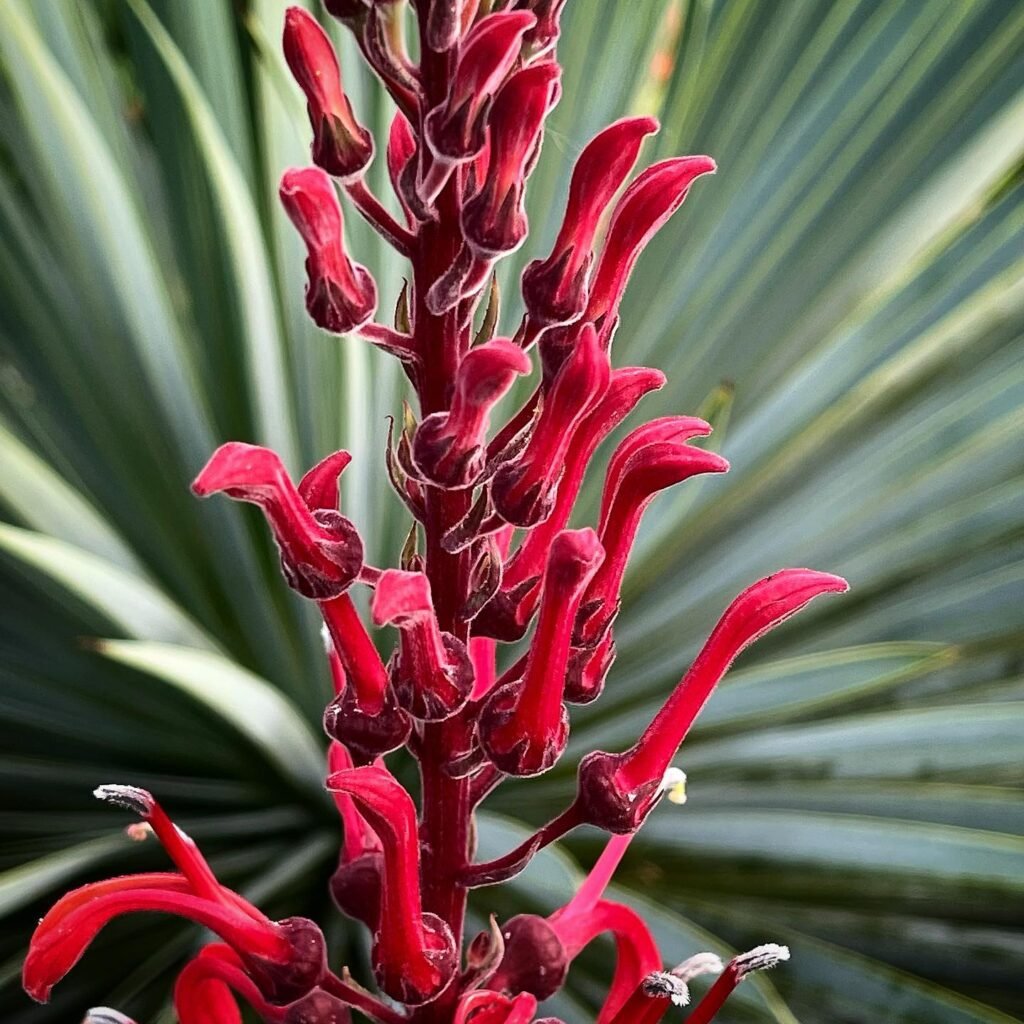
Lobelia Tupa is a beautiful and low-maintenance plant that requires minimal pruning to keep it looking its best. Regularly inspect the plant for any dead or damaged foliage and remove it as needed. This will help maintain the plant’s appearance and ensure its overall health.
Another important maintenance task for Lobelia Tupa is deadheading spent flowers. By removing the faded flowers, you can encourage continuous blooming and prolong the plant’s display of vibrant red blossoms.
In colder regions, Lobelia Tupa may die back to the ground during winter. To prepare the plant for the coming season, cut back the dead foliage in early spring before new growth emerges. This will help maintain the plant’s shape and prevent any dead material from inhibiting new growth.
To protect Lobelia Tupa from extreme cold temperatures, consider applying a layer of mulch around the base of the plant. This will insulate the roots and provide added protection against frost and freezing temperatures.

Propagating Lobelia Tupa (Devil’s Tobacco)


If you want to expand your collection of Lobelia Tupa plants or share its beauty with friends, propagating this stunning perennial is a great idea. Lobelia Tupa can be propagated through division or by taking stem cuttings, both of which are relatively straightforward.
Division
Division is best done in early spring or fall when the plant is not actively growing. To divide Lobelia Tupa, dig up the plant and carefully separate the clumps, making sure each division has a good root system. This can be done by gently pulling the clumps apart or using a sharp garden knife to cut through the root system. Once divided, replant the clumps in well-prepared soil, ensuring they are placed at the same depth as they were before. Water thoroughly after planting to help the divisions establish.
Stem Cuttings
If you prefer to propagate Lobelia Tupa using stem cuttings, this method is best done in early summer. Start by selecting healthy, non-flowering stems from the parent plant. Using a sharp and sterilized knife or pruners, take cuttings that are around 4-6 inches in length. Remove the lower leaves from the stem, leaving a few pairs of leaves at the top. Dip the cut end of the stem in a rooting hormone, if desired, to encourage faster root development. Plant the cutting in a moist soil mixture or a well-draining potting mix. Keep the cuttings in a warm and humid environment, such as a propagator or a plastic bag loosely covering the pot, and water them regularly to maintain moisture. After a few weeks, the cuttings should develop roots, at which point you can transplant them into individual pots or directly into the garden.

Repotting Tips
Lobelia Tupa is a stunning perennial plant that typically does not require repotting. However, there may be instances where repotting becomes necessary, such as when the plant becomes overcrowded or outgrows its current container. Follow these repotting tips to ensure a successful transition for your Lobelia Tupa:
- Choose a slightly larger pot with good drainage to accommodate the growing roots of your Lobelia Tupa.
- Fill the new pot with well-draining potting soil, which will help prevent waterlogged roots and promote healthy growth.
- Carefully remove the plant from its current pot, gently loosening the roots and untangling any that have become twisted or compacted.
- Place the plant in the new pot, ensuring that it is positioned at the same depth as in the original pot.
- Fill in the gaps around the plant with additional potting soil, pressing down gently to secure the plant.
- Water the newly repotted Lobelia Tupa thoroughly to settle the soil around the roots and provide the hydration it needs.
Benefits and Uses of Lobelia Tupa
Lobelia Tupa, with its captivating beauty, offers numerous benefits and has versatile uses in UK gardens. Its striking red flowers attract pollinators such as butterflies and bees, making it an excellent choice for creating a vibrant and lively garden ecosystem.
But the benefits of Lobelia Tupa don’t stop there. This remarkable plant also possesses medicinal properties and has been traditionally used to treat respiratory
conditions, including asthma and bronchitis. Its leaves, when prepared correctly, can be used in various respiratory remedies.
“Lobelia Tupa’s nectar-rich flowers are a magnet for butterflies and bees, adding life and color to your garden.” – Gardening Expert, Oliver Greenway
However, it is crucial to exercise caution when using Lobelia Tupa for medicinal purposes. It is strongly recommended to consult with a healthcare professional before attempting any self-treatment. They can provide guidance on the appropriate usage and dosage tailored to your specific needs.
Key Points:
- Lobelia Tupa attracts pollinators such as butterflies and bees to UK gardens.
- It possesses medicinal properties and has been used to treat respiratory conditions.
- Consulting a healthcare professional is recommended before using Lobelia Tupa for medicinal purposes.
Growing Lobelia Tupa in the UK
When it comes to growing Lobelia Tupa in the UK, this stunning plant is well-suited for regions with milder climates. Whether you have a border garden, container garden, or want to create a focal point in your yard, Lobelia Tupa can add a touch of exotic beauty.
To ensure success in your UK garden, it’s important to choose Lobelia Tupa plants from reliable nurseries or online retailers that specialize in native and exotic plants. These plants have been acclimated to the UK’s growing conditions and are more likely to thrive in your garden.
Helpful Videos about Growing Lobelia Tupa
Fancy getting into growing Lobelia Tupa? I’ve got some brilliant videos sorted for you. They’re chock-full of simple advice to give your plant the best start, from the basic know-how to a couple of savvy tips. Perfect for the green-thumbed pros as well as newcomers to the plant scene, these guides are all about making Lobelia Tupa care straightforward and fun.
- Lobelia Tupa Care, How to Grow Devil’s Tobacco
- Ciscoe’s Favorite Plants: Lobelia Tupa
Frequently Asked Questions about Growing Lobelia Tupa

Keen on getting your Lobelia Tupa to thrive? Jump into my detailed FAQ for top-notch advice on nurturing your Lobelia Tupa. From the right amount of sunlight to watering dos and don’ts, and all the care in between, I’ve gathered everything you need for a flourishing beauty.
It’s a striking plant known for its tall spikes of red flowers. The name comes from its toxic properties, similar to tobacco.
It loves the sun! Aim for at least 6 hours of direct sunlight each day.
It’s a bit fussy with frost. Protect it or bring it indoors in colder areas.
Water it when the top inch of soil feels dry. It prefers to stay on the drier side.
Well-draining soil is key. Mix in some organic matter for the best results.
A bit of general-purpose fertiliser in spring will do wonders.
It can shoot up to 2 metres tall and spread about 60 cm wide.
Trim back in late autumn to tidy it up and encourage bushy growth next season.
Yes, you can grow it from seeds or take stem cuttings in summer.
Keep an eye out for aphids and slugs, but generally, it’s quite hardy.
Absolutely, just ensure the pot is big enough and has good drainage.
Mulch around the base and consider fleece in very cold regions.
Early spring, after the last frost, is ideal.
Yes, it’s toxic if ingested, so keep it away from pets and kids.
Overwatering is a common cause. Let the soil dry out a bit more between waterings.
Ensure it gets enough sunlight and consider a bloom-boosting fertiliser in the growing season.
It could be due to insufficient sunlight or nutrients. Make sure it’s well-positioned and fed.
I trust this sorts out how to look after your Lobelia Tupa. Got any more questions? Just sling them in the comments, and I’ll get back to you. Bear in mind, we all start from square one, and getting to know your plants is a cracking adventure.

